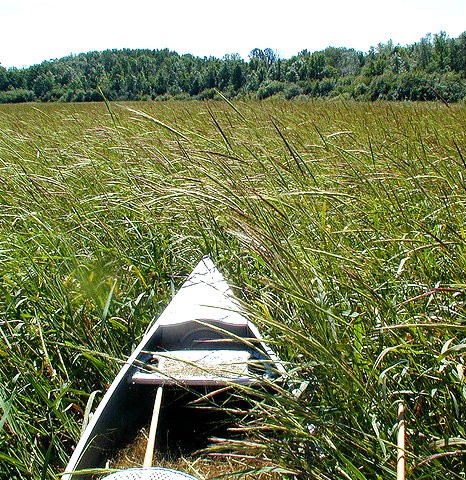The good grain: Restoring wild rice in the North

Ahead of me, stumbling down an embankment, a 16-year-old boy drags a 50-pound bag of recently harvested rice seed toward the river bank. He’s a volunteer and part of a wild rice restoration project organized by the local county juvenile court, the Keweenaw Bay Indian Community and the Great Lakes Indian Fish and Wildlife Commission. Our aim is to plant 2,100 pounds of wild rice seed (zizania palustris) at seven different sites across two rural counties in northern Michigan.
Once a treasured source of nourishment and sacred meaning for Native Americans of the upper Midwest, natural stands of wild rice (manoomin in the Anishinaabe language) are diminishing because of the loss of wetlands and the dominance of more profitable commercial growers in California. Though wild rice glimmers with trendy back-to-nature appeal—and, to the chagrin of many Native American communities, wild rice packages are often marketed with an American Indian insignia—90 percent of all wild rice is now grown in rice paddies in northern California. Only a small percentage is harvested by any business related to Native Americans.
Read our latest issue or browse back issues.
Domestication of wild rice began in the 1950s. Corporations perceived the potential profit in this unique cereal grain, native only to the North America continent. Academic institutions provided research on improving production and developing new seed stock. The focus on efficiency in planting and harvesting was accompanied by rising environmental problems in the Midwest regions that are home to wild rice. Scott Herron, an ethnobotanist of Odawa lineage who directs the Wild Rice and Ethnobiology Lab at Michigan’s Ferris State University, notes that in the post–World War II years wetlands in the Midwest were drained and lakes dammed, and the widespread use of herbicides and pesticides often destroyed the delicate water conditions needed for wild rice production.
The tribal rice harvesters that remain are typically small-scale operations, mostly family-based. The rice they harvest is distributed regionally. One of the few tribal producers opting for national distribution is Native Harvest, a branch of the nonprofit White Earth Land Recovery Project. It sells rice online. However, it can’t match the selling price of the paddy industry, which has limited labor costs and uses domesticated high-yield, large-sized grains.
Herron says it makes no sense to compare wild rice to most agricultural products. Producing wild rice is like making maple syrup or harvesting morel mushrooms; producers can survive only when customers are willing to pay more for the real thing—and when customers know what the real thing is. As it is, California and Canadian paddy rice is imported to the Midwest, and consumers tend to believe they’re purchasing a local product.
The Anishinaabe (Ojibwa, Potawatomi and Odawa) Indians say that from their beginnings, wild rice has been a sacred food. Their legends tell of traveling to find a place where “food would be growing on water.” Common names for rivers, townships and villages in northern Minnesota, Wisconsin and Michigan derive from the Ojibwe word for wild rice, manoomin (literally “good grain”), and ininii (“people”). The city of Menominee, for example—the name of a town in the upper peninsula of Michigan—comes from the Native American word for “people of the wild rice.” Few current residents of these places are aware of this historical legacy.
Jacques Marquette, a Jesuit missionary to the Midwest in the 17th century, first penned detailed notes about ceremonies and traditions that framed the rice harvesting practices of the Anishinaabe. A few years later, the French explorer Pierre-Esprit Radisson, during travels in what is now Wisconsin, left this account: “Our songs being finished, we began to put our teeth to work. We had a meal of a kind of rice much like oats. It grows in water three or four feet deep. Indians have a particular way to gather up that grain. Two take a canoe and two sticks by which they pull the ear down, and knock the grain off the plant stems. Their boat being full, they bring the grain to a fit place and dry it. This is their food for most of the winter. For a meal, each gets a handful that they put into a cooking pot. It swells much that it can suffice a man.”
Jan Schultz, chief botanist for the eastern region of the U.S. Forest Service, calls wild rice a “keystone species,” one important indicator of a healthy, complex interplay of fragile ecosystems. It plays a specific role in the biodiversity of wetlands. It provides habitat and food for ducks and wildlife, and its roots serve as a natural erosion control, cleansing the waters of streams and shallow lakes by absorbing nutriments. To flourish, manoomin needs subtle seasonal fluctuations of water levels and an aquatic environment clear of pesticides and toxins.
The Great Lakes Indian Fish and Wildlife Commission, established in 1984, is an intertribal organization that assists 11 member tribes in implementing their off-reservation treaty harvesting rights. Along with conducting tribal-related research and monitoring fish and wildlife, the agency seeks to protect the local traditions of wild rice harvesting. It’s a tough challenge. Complex issues about treaty rights add to a long-standing contentious relationship between state governments and tribal entities.
It’s late afternoon. Our small work team sits perched under a grove of white pine trees on a moss-covered granite ledge overlooking one of today’s last planting sites. Don Chosa, a tribal member and experienced guide, talks to us about planting techniques and traditional harvesting protocol. A question is raised about how seeds survive the winter season’s ice and bitter cold. Chosa replies that the ice “actually helps the process . . . forcing seed into the lake’s muddy bottom. It takes three or four months of below-freezing weather before wild rice seed germinates. To work with wild rice, one needs extraordinary patience while holding to a promise.”
The nature of such resilience is worth pondering. Respectful inquirers will note that the prayers and ceremonies of traditional Native American rice harvesters have helped them sustain a vision, against the odds, of a September harvest.
Writer and social critic Lewis Lapham closes a recent essay by suggesting that the early years of the 21st century are ripe for the “redrafting of the contract between man and nature . . . of a magnitude comparable to the one that gave birth to the Renaissance.” The struggle of the Anishinaabe to protect their wild rice beds and their communities’ fragile spiritual traditions give us a sense of what that redrafting will entail.





